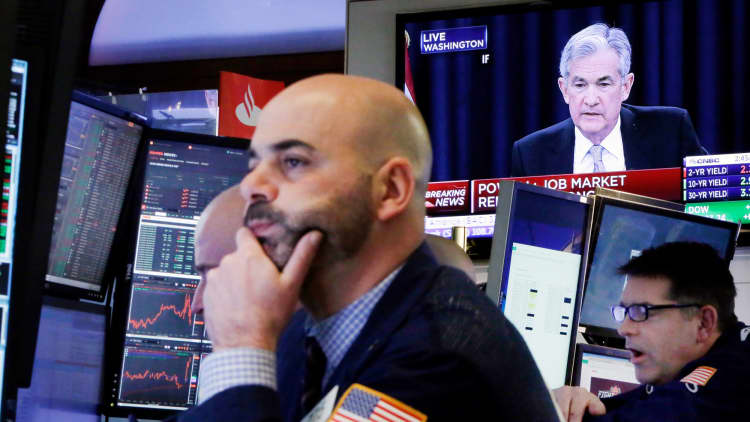With stocks down significantly, corporate buybacks could help stabilize the market.
Buybacks have been one of the big stories supporting the market this year. DataTrek estimates that in the last 12 months, the companies in the S&P 500 have purchased $646 billion of their own stock, 29 percent more than the previous 12 months.
And there's plenty of "dry powder" left. One firm estimates at least $350 billion of buybacks that have been planned for the year and are just waiting to be put to work.
And no, it is not just Apple that is buying its own stock. More than 300 large-cap companies have active buyback programs.
Unfortunately, some traders are resurrecting an old chestnut to help explain the current market weakness. They say we are entering a "blackout" period, when corporations cannot buy their stock because they are about to report quarterly earnings.
It's a neat explanation, except there's not a lot to it.
"Buybacks do occur during blackout periods," Ben Silverman at InsiderScore told me. "Buyback volume does often decline in the first month of the quarter due to some buyback blackouts," but companies can, and do, continue to buy back stock, he told me.
Another trader (who declined to be identified) confirmed Silverman's point. Corporate buybacks decline in the month before earnings, but only marginally. He estimated the decline is 30 percent or less.
Here are the facts about buybacks and "blackout periods:"
1. Most companies have policies about insider buying and selling. To avoid accusations that companies and their executives are trading on insider information, most companies restrict or will not allow trading in their stock in the immediate period prior to an earnings release. There is no federally mandated blackout period. Companies decide themselves when and if they want to restrict corporate and insider buying or selling. The rules vary by company, but Silverman noted that a typical trading window closes two weeks before the quarter ends and stays closed until just after earnings are released.
2. Companies can continue to buy back stock even during a blackout period. Under SEC Rule 10b5-1, corporations are permitted to trade providing the companies have set up a plan to buy back stock on a regular, defined basis. There are certain restrictions, like not being able to buy in the last 10 minutes of trading.
If they follow these guidelines, they are afforded a "safe harbor" against any insider trading accusations.
And that is exactly what many companies do.
Take J. P. Morgan, which reported earnings on Friday. In its 2017 annual report, the company said it bought back 47 million shares in the fourth quarter of 2017, averaging 16 million shares in each of the three months in that quarter. Here's how the share buybacks broke down by month:
JP Morgan: Q4 2017 buybacks
October: 14.2 million shares
November: 19.4 million shares
December: 14 million shares
Source: company filing
Last year, J. P. Morgan reported its third quarter earnings on October 12, 2017. The 14.2 million shares it bought in October was less than it bought in November, but about the same amount it bought in December.
The company explained in a filing: "The Firm may, from time to time, enter into written trading plans under Rule 10b5-1 of the Securities Exchange Act of 1934 to facilitate repurchases in accordance with the common equity repurchase program. A Rule 10b5-1 repurchase plan allows the Firm to repurchase its equity during periods when it would not otherwise be repurchasing common equity - for example, during internal trading blackout periods."
The company is telling you that it likely had a 10b5-1 plan and stuck to it, even buying through the "blackout period."
I'll give you one other example from one of the biggest buyback monsters, Apple.
In its second quarter report, Apple told us exactly how much stock it bought back, and when, during the three months that ended on June 20th.
It shows Apple was a big buyer of its stock in the period immediately before it reported earnings on May 1.
Here are the numbers from its regulatory filing:
From April 1 through May 5, Apple bought 67,707 shares at an average price of $170.46.
From May 6 through June 2, it bought 22,026 shares at an average price of $187.56.
From June 3 through June 30, it bought 23,045 shares at an average price of $187.78.
Notice something important: Apple bought back more shares in the month before it reported earnings (May 1) than it did in the two months after the earnings release.
Apple not only bought back shares, it bought them smartly. It bought more during the period when the stock price was lower (April 1 to May 5), and bought back less during the periods when it was higher (May 6 to June 2 and June 3 to June 30).
The $350 billion in unused buybacks is a lot of "dry powder" for the market. That is a significant amount of money that could be allocated back into the market, particularly with share prices down.
Corporate buyback plans typically work on a dollar basis, meaning corporations will seek to buy back a certain amount of dollar value of their stock on a daily basis. With prices down, corporations can buy back more stock, and they may even get more aggressive.
When does the music stop? I don't know, but American companies are generating enormous free cash flow. Cash and cash equivalents are still high. We are not seeing aggressive leveraging up of balance sheets to buy back stock — most are not issuing debt to buy back stock.
Unless companies can find an attractive use for all that excess cash, such as hiking dividends or using cash for M&A, I'm betting companies will still funnel the majority of their excess cash to buybacks.
WATCH: Five market experts break down how to invest as interest rates spike



